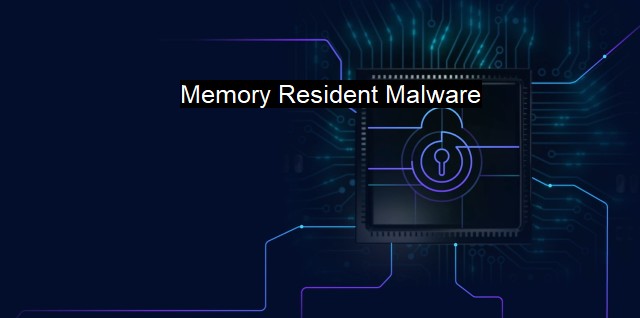What is Memory Resident Malware?
Silent Threats: The Elusive and Dangerous Nature of Memory Resident Malware
Memory resident malware, a subtype of malware, is undoubtedly a prominent cybersecurity issue intricately entangled with the discussion regarding antivirus solutions. A more profound understanding of memory resident malware and subsequent implementation of remedial measures would significantly foster an organization’s cybersecurity framework.To get to grips with memory resident malware, a grasp of the nature of malware is fundamental. Malware, be it a trojan, worm, or adware amongst its multiple variants, is malicious software designed to inflict damage, compromise data, operating systems, networks, or anything that contributes to the conventional operations of a digital infrastructure.
One class of such menaces is the memory resident malware, which comes about as an outcome of technological advancements since memory resident malware mostly plants itself in Random Access Memory (RAM). Memory resident malware functions autonomously by managing to persist in memory even post the removal of the host application, making it highly noticeable in the cybersecurity landscape.
Memory resident malware encompasses viruses that attach themselves directly into the system memory, thereby rendering the devices vulnerable and exploitable. They are memory-resident because they continue to live within the systems' RAM, detrimental to speed, and overall system performance.
Compounding the issue, it is also worth noting that memory resident malware, given they largely infect system memory, is more challenging to detect and far more dangerous, as it is capable of corrupting data and software and disrupting business paradigms. The introduction of memory resident malware into digital perimeters enhances the potency of cybersecurity attacks.
Like all malwares, memory resident malware also takes root from user actions, such as clicking on malicious links, underestimated regular software updates, or opening dubious-looking emails. They are encoded to load a portion of in-memory processes residing in the System RAM as the computer boots up, camouflaging behind benign software programs.
The memory resident malware possess broader functions like keystroke logging, Mimikatz (to lift usernames and passwords), comparable to the arsenal of a trojan. Likewise, there are cases of spy-shipping, extortion, and so forth. Memory resident malware’s persistent and malignant attack vector changes prevention measures into a relentless task, upgrading and intensifying targets for information theft.
Antivirus solutions actively recognize this challenge. Antivirus software protects against malware, including memory resident malware, although elimination is undoubtedly cumbersome due to evasion tactics and persistent presence possibly reinfecting systems. These From heuristic analysis to real-time scanning, antivirus utilizes a host of measures at every level of system operation, categorizing unusual activities and consequently blocking it.
In the changing dynamics of cybersecurity, methods to remove memory resident malware represent an industry challenge. Mitigation approaches frequently include creating effective incident response plans, adhering to strict user access controls, creating backups, and updating antivirus software regularly. This holistic approach oo defense is a frontline strategy against the stealth attacks of memory resident malware.
The sophisticated landscape of memory resident malware elevates discussions about the more extensive cybersecurity architecture and antivirus solutions. Despite the continuation of more viable attempts to develop precautionary solutions, the volatility of memory resident malware utterly perceptible. It sustains a severe threat to devices’ cybersecurity and user privacy, slowing down system performance, network traffic, and ubiquitously wreaking havoc invisibly.
An effective defense against memory resident malware depends on keeping up with the course of understanding its elusive behavior. Vigilance and education, merged with a compact cybersecurity system, can deliver remedy to this continuing predicament. Given the complex nature of this matter, it indeed validates the need to invest time and resources genuinely into antivirus solutions elemental to assure cybersecurity and sustain effective sacrosanct digital infrastructure in both organizational and personal domains.

Memory Resident Malware FAQs
What is memory resident malware and how does it work?
Memory resident malware is a type of malware that resides in a computer's memory after it has been executed. This type of malware is designed to evade detection by traditional antivirus software and can perform various malicious activities on the infected machine, such as stealing sensitive information, modifying system settings, and installing additional malware.How does memory resident malware differ from other types of malware?
Unlike other types of malware, memory resident malware is designed to remain undetected in a computer's memory, making it difficult to detect and remove. Additionally, memory resident malware can persist even after rebooting the infected machine, allowing it to continue its malicious activities.What are some common signs that a computer may be infected with memory resident malware?
Some common signs that a computer may be infected with memory resident malware include slow system performance, unexplained pop-ups or alerts, unusual network activity, and unexplained modifications to system settings or files. If you suspect that your computer may be infected, it is important to run a reputable antivirus program to detect and remove the malware.How can I protect my computer from memory resident malware?
To protect your computer from memory resident malware, it is important to keep your antivirus software up to date and to avoid downloading software and files from untrusted sources. Additionally, you should regularly scan your computer for malware and be cautious when opening emails or clicking on links from unknown or suspicious sources.| | A | | | B | | | C | | | D | | | E | | | F | | | G | | | H | | | I | | | J | | | K | | | L | | | M | |
| | N | | | O | | | P | | | Q | | | R | | | S | | | T | | | U | | | V | | | W | | | X | | | Y | | | Z | |
| | 1 | | | 2 | | | 3 | | | 4 | | | 7 | | | 8 | | |||||||